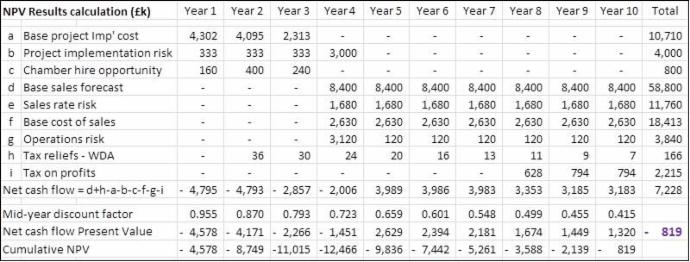Worked Example of an NPV Model - A Space Industry Project
This worked example is based on a project being considered for approval by a company working in the Space industry. The project would develop and prove a new unit e.g. battery cell or processor to customers who are building space systems e.g. satellites. The relevant costs and benefits can be summarised as follows:
- Production cost per unit: £200k.
- Selling cost per unit: £700k.
- Other costs of sales (management, marketing and test chamber time: £230k per annum.
- Potential sales: 20 per annum.
- Estimated sales opportunities conversion rate: 60%.
- Unit development cost: £10.7m including £1m on special tools and test equipment (STTE) which would be treated as assets for tax purposes.
- Unit development period: 3 years.
- Subsequent sales window: seven years.
- Opportunity cost: £400 per annum profit on declined customer contract to hire environmental chamber during the unit development period.
- Provision for unit development risk: £4m, including a provision for development prolongation of up to one year e.g. caused by the need for an additional design and test cycle.
- Associated risk that development prolongation would delay commencement of sales.
- Provision for sales risk of 20% caused by the market for sales being reduced by delays to customer programmes.
- Provision of cost risk for production yield rate : 5% of production costs.
- Corporation tax on project-specific profits from the point at which they are realised.
- Tax reliefs on the write down of assets (WSA).
Estimates in the model are made at constant cost. However, the company's discount rate of 13% is calculated at nominal rates i.e. including inflation. The discount rate thus has to be adjusted downwards to represent the company's cost of capital at real rates. The effects of inflation on the project's cost and benefits. Hence the discount rate for the model is approximately 9.7% (see this page for the relevant formula).
The full Excel NPV model can be downloaded from this link.
The results from the model are summarised in the figure below. The project NPV is shown at the bottom of the last column in purple font. Note that, since the forecast NPV is negative and the project lacks any identified non-cash benefits, it would normally be rejected.

Notes
- Some of the choices made when structuring this model may be different to the ones that you would make in many circumstances. For example, the modelling of corporation tax is equivalent to that of treating the project as a stand-alone business. In practice, a company's finance function may advise that the tax implications of costs and sales should be modelled separately, thereby combining them with other company activities.
- The book NPV and Risk Modelling for Projects includes this model in Chapter 4 as Model 4.1. It also provides a fuller explanation of the project context and includes a variant model that treats taxation and opportunity costs in a different manner and includes inflation in costs and benefits on the basis that tax liabilities would be borne slightly later than the associated costs and benefits.
- As with any NPV model, this example is predicated on a number of important assumptions, some explicit (because they underpin the estimates) and others implicit to choices made when structuring the model. It is good practice to ensure that all such assumptions are recorded and made known to the people who use the NPV forecast for decision making purposes. Relevant assumptions have been listed at the top of the Excel sheet that can be downloaded above.